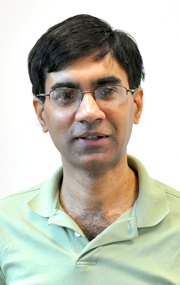Pinaki Sengupta
Associate Professor

| Phone: | (65) 6592 1801 |
| Email: | psengupta@ntu.edu.sg |
| Education: | M.Sc. (Physics), Indian institute of Technology, Kanpur, India PhD, University of Illinois at Urbana Champaign, IL, USA |
Research Interests
Strongly correlated systems
My research interests lie in exploring the physics of strongly interacting many body systems in reduced dimensionality combining analytical and numerical approaches, focusing on exotic ground states and quantum phase transitions. The study of strongly correlated systems is among the most active frontiers in contemporary condensed matter physics. Unlike simple metals, e.g., copper, whose properties are well described in terms of non-interacting conduction electrons moving in a uniform potential (Landau Fermi liquid theory), one cannot ignore the effects of interactions between particles, e.g.,Coulomb interactions, especially at low temperatures.
The interplay between multiple interactions and external potentials like applied magnetic fields result in novel quantum states of matter in these systems. The search for such exotic phases is driven by fundamental and technological motivations. The technological interest results from the possibility of novel functionalities -- such as colossal magnetoresistance and high temperature superconductivity -- associated with these new states of matter. The theoretical motivation lies in understanding the nature of fundamental interactions in matter.
I use computational and analytical approaches to develop theoretical frameworks (based on microscopic models) to explain the emergence of such novel quantum phases in a number of strongly correlated systems including various spin systems and ultracold atoms in optical lattices. Some specific problems I am currently working on include the following.
Spin supersolid phase
The supersolid (SSOL) is a novel state of matter that has not been observed unambiguously in nature. The detection of possible SSOL features in recent experiments on solid 4He has led to a resurgence of interest in this novel state of matter that has never been conclusively observed in nature. While the fate of the SSOL phase in the continuum (solid 4He) remains inconclusive, my collaborators and I demonstrated that it can be stabilized in the presence of an external lattice. The recent breakthroughs in observing Bose-Einstein condensation and other novel phases in spin dimer compounds motivated me (in collaboration with Cristian Batista) to extend the search of supersolid phase to magnetic systems. We showed that under realistic conditions the supersolid phase can be induced in a spin system by applying a uniform external field. The key ingredients necessary are S=1 dimerized structure and a frustrated inter--dimer coupling.
I am working closely with the experimental group at the National High Magnetic Field Laboratory (NHMFL) at the Los Alamos National Laboratory to identify real materials with the appropriate structure which can be used to realize the supersolid phase.
Quantum magnetism in high magnetic fields
The rapid advance in the field of materials synthesis has produced a wide variety of spin compounds with different moments, interactions and geometries. I have been working with different experimental groups in the US and UK to understand the be behavior of several of these compounds. These include the demonstration of Berezinskii-Kosterlitz-Thouless type transitions in quasi two-dimensional organic quantum magnets, extracting an direct estimator for the short range spin correlations based on magnetostriction measurements, detailed exploration of BEC of magnons in several quantum magnets and explaining the emergence of magnetization plateaus in the geometrically frustrated Shastry-Sutherland compounds.
Ultracold atoms in optical traps
A rapidly emerging field of research lies at the interface of atomic and condensed matter physics. Magneto-optic trapping and evaporative cooling of atoms has made possible a new realization of many of the classic problems which underlie materials science: How do interparticle interactions generate (Mott) insulating states? How does a mixture of bosonic and fermionic atoms give rise to pairing? What effect does an imbalance in population of up and down spin fermions have on superconductivity? I study the physics of tight-binding Hamiltonians like the Hubbard model whose behavior links these atomic and condensed matter systems.
Selected Publications
- Sengupta, P.; Pryadko, L. P.; Alet, F.; Troyer, M.; Schmid, G. Supersolid versus phase separation in two-dimensional lattice bosons, Phys. Rev. Lett. 94, 207202 (2005).
- Sengupta, P.; Cristian Batista. Field-induced supersolid phase in Spin-one Heisenberg models, Phys. Rev. Lett. 98, 227201 (2007).
- Sebastian, S. E.; Harrison, N.; Sengupta, P.; Batista, C. D.; Francoul, S.; Palm, E.; Murphy, T.; Dabkowska, H. A.; Gaulin, B. D. Fractalization drives crystalline states in a frustrated spin system, Proc. Natl. Acad. Sci. (USA) 105, 20157 (2008).
- Sengupta, P.; Stephan Haas. Quantum glass phases in the disordered Bose-Hubbard model, Phys. Rev. Lett. 99, 050403 (2007).
- Sengupta, P.; Rigol, M.; Batrouni, G. G.; Denteneer, P. J. H.; Scalettar, R. T. Phase coherence, visisbility, and the superfluid--Mott-insulator transition on one-dimensional optical lattices, Phys. Rev. Lett. 95, 220402 (2005).